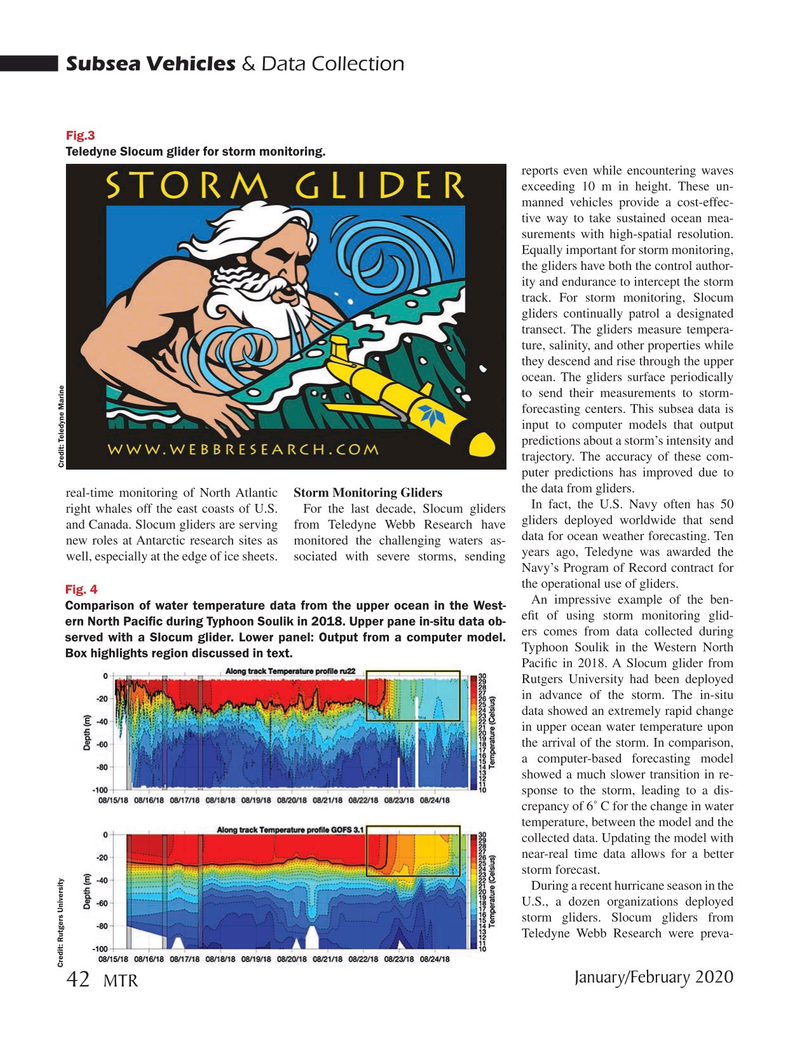
Page 42: of Marine Technology Magazine (January 2020)
Read this page in Pdf, Flash or Html5 edition of January 2020 Marine Technology Magazine
Subsea Vehicles & Data Collection
Fig.3
Teledyne Slocum glider for storm monitoring.
reports even while encountering waves exceeding 10 m in height. These un- manned vehicles provide a cost-effec- tive way to take sustained ocean mea- surements with high-spatial resolution.
Equally important for storm monitoring, the gliders have both the control author- ity and endurance to intercept the storm track. For storm monitoring, Slocum gliders continually patrol a designated transect. The gliders measure tempera- ture, salinity, and other properties while they descend and rise through the upper ocean. The gliders surface periodically to send their measurements to storm- forecasting centers. This subsea data is input to computer models that output predictions about a storm’s intensity and trajectory. The accuracy of these com-
Credit: Teledyne Marine puter predictions has improved due to the data from gliders. real-time monitoring of North Atlantic Storm Monitoring Gliders
In fact, the U.S. Navy often has 50 right whales off the east coasts of U.S. For the last decade, Slocum gliders and Canada. Slocum gliders are serving from Teledyne Webb Research have gliders deployed worldwide that send data for ocean weather forecasting. Ten new roles at Antarctic research sites as monitored the challenging waters as- well, especially at the edge of ice sheets. sociated with severe storms, sending years ago, Teledyne was awarded the
Navy’s Program of Record contract for the operational use of gliders.
Fig. 4
An impressive example of the ben-
Comparison of water temperature data from the upper ocean in the West- e? t of using storm monitoring glid- ern North Paci? c during Typhoon Soulik in 2018. Upper pane in-situ data ob- ers comes from data collected during served with a Slocum glider. Lower panel: Output from a computer model.
Typhoon Soulik in the Western North
Box highlights region discussed in text.
Paci? c in 2018. A Slocum glider from
Rutgers University had been deployed in advance of the storm. The in-situ data showed an extremely rapid change in upper ocean water temperature upon the arrival of the storm. In comparison, a computer-based forecasting model showed a much slower transition in re- sponse to the storm, leading to a dis- crepancy of 6° C for the change in water temperature, between the model and the collected data. Updating the model with near-real time data allows for a better storm forecast.
During a recent hurricane season in the
U.S., a dozen organizations deployed storm gliders. Slocum gliders from
Teledyne Webb Research were preva-
Credit: Rutgers University
January/February 2020 42
MTR
MTR #1 (34-49).indd 42 1/17/2020 1:30:51 PM

 41
41

 43
43
